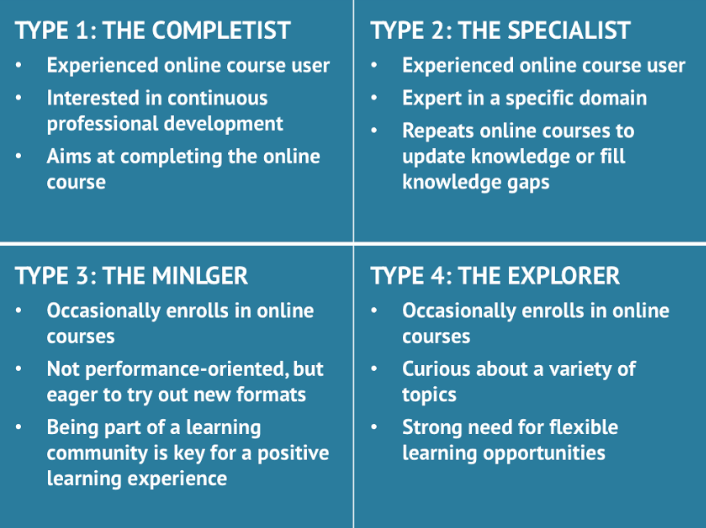Making sense of our connected world

Click Cliques: User Types in Online Learning
It should have been an educational game changer. The world’s top universities were offering courses online, free to anyone with an Internet connection. Enthusiasm was high, as was enrollment. But surprisingly few participants ended up completing their courses. Associated researcher Anna Hansch sought to understand why. In her dissertation, she examined how users respond to some of the new approaches that online learning platforms use to spark engagement, such as gamification. The result of her empirical analysis is the development of a user typology, and several recommendations for designing online courses that truly foster meaningful engagement.
Massive Open Online Courses (MOOCs) kickstarted new possibilities for online learning. World-renowned institutions of higher learning can now offer free courses to anyone via the Internet. Education is transforming from a few years of strictly organized, on campus studying into lifelong learning that fits participants’ schedules and geographical constraints. To date, 81 million learners have signed up for 9,400 courses on a variety of topics, from machine learning to graphic design.
Universities aren’t the only ones taking advantage of online learning platforms. Businesses have also started using online courses to train employees. In the ongoing shift from an industrial to an information economy, many workers must keep pace with technological developments affecting their positions, like the expanding role of robotics and artificial intelligence. Online courses can specifically cater to a company’s training needs, keeping their employees a step ahead of the technology, and their business a step ahead of the competition.
Pass or Fail?
Despite the promise of free online courses, they’ve been criticized by both educators and researchers for their low user engagement and low completion rates, which range between 5% and 16%. Since user engagement is an invaluable component of the learning process, the potential for success of this new educational format is starting to be reconsidered.
One possible reason for the shortcomings of online courses is their focus on technology over pedagogy. Developed by entrepreneurial non-educators with little research into the success factors of previous online learning attempts, early MOOCs were especially tech-centered and tested more for their marketability than educational success.
Get your head in the game
As online learning providers continue to search for new ways to improve user experience, they’ve begun experimenting with novel approaches like gamification. These playful additions have real potential to increase engagement. However, gamification tends to be implemented in a one-size-fits-all fashion, without taking actual user interaction into account. Until now, there’s been a dearth of research into how to taylor gamification to users’ specific learning needs and truly encourage meaningful participation.
So what types of users are on gamified online learning platforms? And how can courses be designed around users’ specific learning needs? These are the questions that sparked the research in my dissertation “New Interactions in Online Courses: Developing a User Typology.”
Click cliques: the four types of online course users
Four unique user types in online courses were derived from my qualitative, multi-level study: the Completist (type 1), the Specialist (type 2), the Mingler (type 3), and the Explorer (type 4). Each user type differs in terms of learning strategy, course goal, prefered social learning situation, approach to course material, and response to gamification elements.
The four user types can be further grouped into two camps: content-driven learners, and media-driven learners. The self-motivated content-driven learners (types 1 and 2) actively pick and choose content when and how they want, regardless of the format. The more passive media-driven learners (types 3 and 4) expect course content to be presented with all the bells and whistles of modern media, creating an engaging learning adventure.
Here’s your homework: Designing for the user types
The conclusions of my dissertation indicate that the high drop-out rates in online courses are a symptom of their lack of user-centered design. Paradoxically, even though online learning platforms are entirely Internet-based, the courses fail to take into account how users actually interact with digital media in their everyday life.
To address these shortcomings, the proposed typology recommends building online courses around the needs of the users. By putting the four user types at the center of course development, online learning platforms can better foster successful lifelong learning and help transform education for the 21st century.
Learn more about the user types and how to design engaging learning experiences around them in the book “Neue Interaktionen in Online-Kursen: Entwicklung einer Nutzertypologie“. Available on epubli.com and other online booksellers.
This post represents the view of the author and does not necessarily represent the view of the institute itself. For more information about the topics of these articles and associated research projects, please contact info@hiig.de.

You will receive our latest blog articles once a month in a newsletter.
Digital future of the workplace
Online echoes: the Tagesschau in Einfacher Sprache
How is the Tagesschau in Einfacher Sprache perceived? This analysis of Reddit comments reveals how the new simplified format news is discussed online.
Opportunities to combat loneliness: How care facilities are connecting neighborhoods
Can digital tools help combat loneliness in old age? Care facilities are rethinking their role as inclusive, connected places in the community.
Unwillingly naked: How deepfake pornography intensifies sexualised violence against women
Deepfake pornography uses AI to create fake nude images without consent, primarily targeting women. Learn how it amplifies inequality and what must change.





